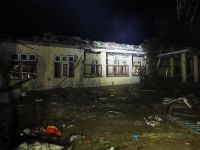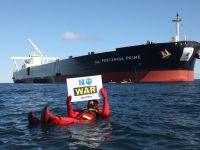Bahrain produces only a modest quantity of oil, but has a strategic location in the Persian Gulf.
Note: The information contained in this report is the best available as of July 2000 and may change.
GENERAL BACKGROUND:
Bahrain is a monarchy ruled by Shaikh Hamad Bin Issa Al-Khalifa, the Amir of Bahrain, who has been in power since March 1999. Geographically, the country is a group of islands off Saudi Arabia - close enough to be linked by a causeway which connects it to the mainland of the Arabian Peninsula. Bahrain also claims the Hawar Islands, which are disputed with Qatar.
The country's economy depends heavily on the oil industry, but it also is an important center for financial services and banking. Oil prices affect Bahrain's economy both directly, as revenues, and indirectly, due to banking and export links to neighboring Persian Gulf countries which depend on oil revenues. In 1998 and early 1999, Bahrain suffered an economic slowdown due to low oil prices.
In late 1999 and 2000, however, Bahrain has recovered along with oil prices, and the country projected to show growth in its real gross domestic product of 4.5 percent in 2000.
Bahrain has a territorial dispute with Qatar over the Hawar Islands off Qatar's west coast. The islands are near the north end of Qatar's Dukhan oilfield, and may contain oil deposits.
The dispute has been submitted to the International Court of Justice (ICJ) in the Hague. Arguments in the case were heard in June 2000, and ruling by the ICJ is expected before the end of 2000.
OIL:
Bahrain has proven oil reserves of only 148 million barrels, all in one oil field - Awali. The Awali field was discovered in 1932, and was the first oilfield developed in the Persian Gulf. It is currently producing around 35,000 barrels per day (bbl/d) of crude oil.
Production peaked at more than 75,000 bbl/d in the early 1970s, but is now nearing depletion. In May 2000, Bahrain awarded a two-year contract to CGG Corporation for a study of the future prospects of the Awali field.
Both Texaco and Chevron are involved in exploration activity in Bahrain. Chevron holds a concession for areas offshore from Bahrain to the west and north of the island. Texaco is involved in exploration elsewhere in Bahrain, both onshore and offshore.
Bahrain is more important, however, as a refining center. The country has a refinery south of Manama with a capacity of 248,900 bbl/d. The Bahrain Petroleum Company (Bapco) refinery was built in 1936, and has since undergone several modernizations.
An $800-million moderization program was begun in 1998, and is scheduled to be completed in 2004. Several foreign firms are involved in various aspects of the work, including Alstom of France.
Apart from the small amount from Bahrain, crude oil processed at the Bapco refinery is from Saudi Arabia, and reaches Bahrain through a subsea pipeline. Saudi Arabia, as a support to Bahrain's economy, provides 140,000 bbl/d of output from its offshore Abu Safa field free of charge, and is paid for the rest. Bahrain exports most of the Bapco refinery's products.
The Bahraini government has recently consolidated the corporate structure of its state-owned petroleum sector, merging the upstream Bahrain National Oil Company (Banoco) into Bapco. The merger was completed in January 2000.
Bahrain also has provided official approval the proposed construction of a second 500,000 bbl/d refinery in Bahrain by the Saudi firm Petroma, but the project is on hold due to problems with arranging financing.
NATURAL GAS:
Bahrain has natural gas reserves of about 3.9 trillion cubic feet (Tcf), most of which consists of associated gas from the Awali oilfield. Bahrain produced 293 billion cubic feet of natural gas in 1998, all of which was consumed locally.
Gas production and processing are the responsibility of the majority state-owned Bahrain National Gas Company (Banagas). Given Bahrain's demand for fuel for electric power generation, unless offshore reserves are located in the next few years, Bahrain will need to become a gas importer.
Qatar, which is planning to build a pipeline for export of gas to Kuwait, has had discussions with Bahrain about the possibility of connecting a Qatar-Kuwait pipeline to Bahrain.
ELECTRICITY:
Bahrain currently has an electric generating capacity of 1.5 gigawatts (GW), and produced 4.7 billion kilowatt hours (bkwh) in 1998. Driven by population growth, Bahrain's electric power consumption is growing at an annual rate of around 5 percent.
Recent capacity expansion has centered on the Hidd power project. Phase One, built in 1999, added 280 megawatts (MW) of gas-fired generating capacity. The Phase Two expansion of the Hidd power project will add another 630 MW of gas fired capacity by 2004. A tender for the Phase Two expansion is expected to be issued later in 2000.
Another priority is improving the country's transmission and distribution infrastructure. Contracts totalling about $60 million were awarded to several foreign firms including Alstom, ABB, Fuji Electric, and Marubeni in March 2000 for upgrade work.
While the subject of privatization has been discussed, it is not expected that Bahrain will move toward privatization of its state-owned electric utility in the near future.
ENERGY OVERVIEW
Proven Oil Reserves (1/1/00): 148 million barrels
Oil Production (1999E): 46,000 bbl/d (of which 35,000 bbl/d was crude oil)
Oil Consumption (1999E): 25,000 bbl/d
Net Oil Exports (1999E): 21,000 bbl/d
Crude Oil Refining Capacity (1/1/00): 248,900 bbl/d
Natural Gas Reserves (1/1/00): 3.9 trillion cubic feet (Tcf)
Natural Gas Production (1998E): 293 billion cubic beet (Bcf)
Natural Gas Consumption (1998E): 293 Bcf
Electric Generation Capacity (1999E): 1.5 gigawatts (GW)
Electricity Production (1998E): 4.7 billion kilkowatt hours (bkwh)
OIL AND GAS INDUSTRIES
Organization: Bahrain Petroleum Company (Bapco); Barhain Natural Gas Company (Banagas)
Major Foreign Oil Company Involvement: Chevron, Texaco
Major Ports: Manama
Producing Oil Fields (production - bbl/d)(1998E): Awali (35,000 bbl/d)
Major Refineries (capacity - bbl/d): Manama (248,900)
SOURCE: UNITED STATES ENERGY INFORMATION ADMINISTRATION.
© 2000 Mena Report (www.menareport.com)







